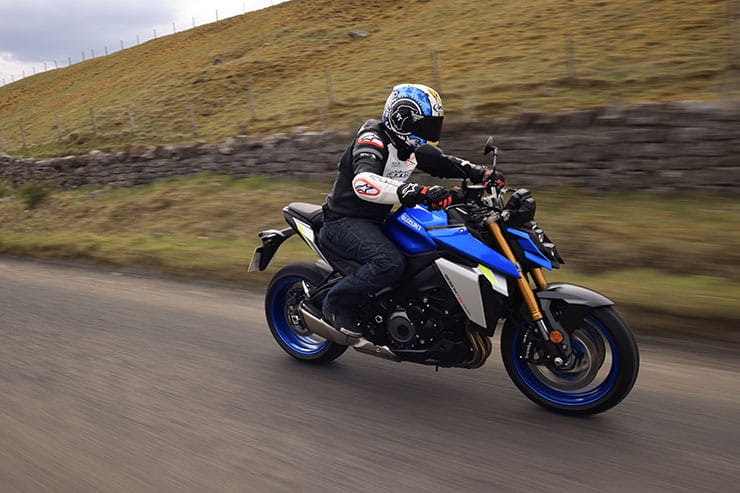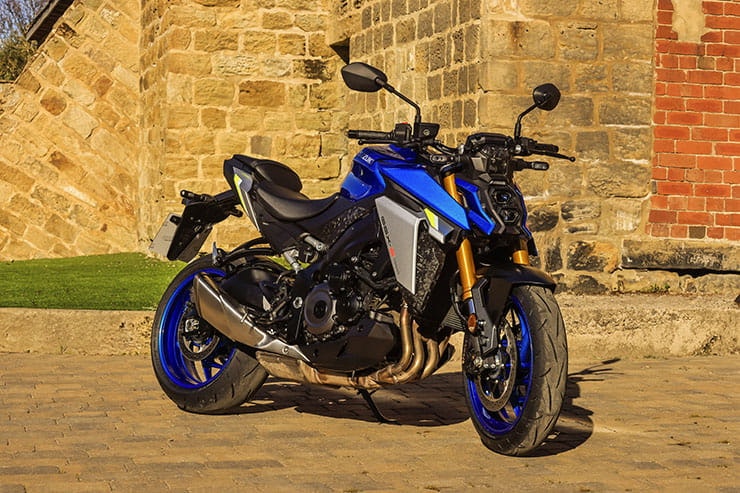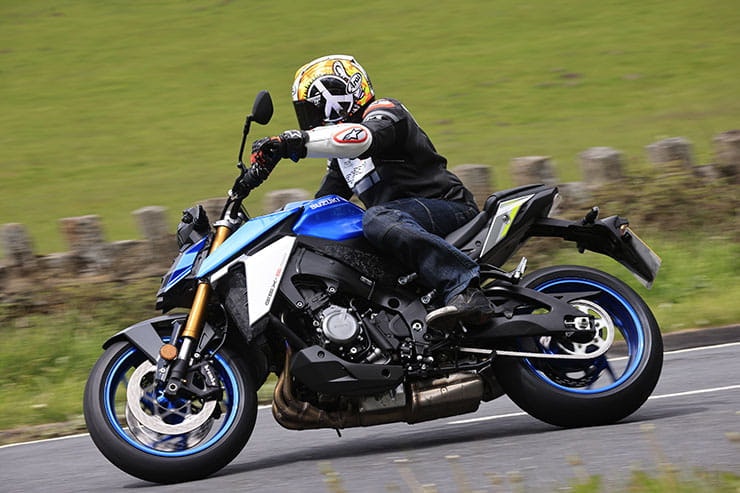Suzuki GSX-S1000 (2021) - Review
BikeSocial Road Tester
06.03.2023
Price is key and at £10,999 Suzuki’s GSX-S1000 is going to be popular on this fact alone. But disregard the attractive price tag for a moment because Suzuki has uprated the 150bhp naked bike for 2021. The engine is now Euro-5 compliant, revs an extra 1000 rpm and, although quoted peak torque is down, Suzuki assures us the torque curve is smoother and fatter than previously. There’s also new electronics, new dash, up-and-down quickshifter as standard, and conventional TC with more refinement – not forgetting those bold new looks.
That might not sound like a huge leap in development, and without any lean-sensitive rider aids, it is behind the competition in terms of technology, but don’t forget that price tag – the reduced level of technology means a significant saving for the end-user.
Grunty engine
Easy handling
Price
Basic rider aids
Weight
Simple dash
Come for a ride on the 2021 Suzuki GSX-S1000
BikeSocial’s road test contributor, Adam Child, offers an in-depth look around the new Suzuki GSX-S1000
Suzuki GSX-S1000 (2021) Price
How much does the Suzuki GSX-S1000 cost? £10,999
The Suzuki is priced considerably lower than the majority of the competition, but it doesn’t appear cheaper; I like the new aggressive styling and the stacked LED headlights. I even like the ‘Camo’ finish on some of the plastics which is available on all three colour options (Metallic Triton Blue, Glass Matt Mechanical Grey or Glass Sparkle Black.
Suzuki informs us that this is a road-focused naked and that its main competitors are Yamaha’s MT-10 (£12,502), Honda’s CB1000R (£11,999) and BMW’s new for 2021 S1000R (£12,035), plus Kawasaki’s Z1000 (£10,649) and Ducati’s underpowered Monster (£10,385), which both undercut the Suzuki on price.
This certainly isn’t a hyper-naked like Ducati’s V4S Streetfighter, which is £9000 more than the Suzuki. For the same price as the Ducati V4S, you could have the Suzuki, plus change to spend on another bike.
And here’s a PCP example:
Power and torque
Suzuki’s engine designers haven’t been working around the clock putting in the overtime. This is more of a tweak than a complete overhaul. And remember, the roots of this engine date back to the epic GSX-R1000 K5, from 2005. Capacity, bore and stroke, compression are the same with new camshafts, camchain and valve springs, along with a new slipper clutch the most significant changes. There’s also a completely new exhaust (to meet Euro-5), along with smaller and lighter electronically controlled throttle bodies. The 40mm throttle bodies (down from 44mm) are designed to give a smoother feeling upon opening.
The end result is an increase from 150ps/147.8bhp @ 10,000rpm to 152ps/149.8bhp @11,000 – not a huge step. However, the increase in rpm is interesting. Peak torque is down from 108Nm/79.7ftlb @ 9500rpm to 106Nm/78.2ftlb @9250rpm, but the all-important the torque curve is now smoother, with a noticeable increase in the mid-to-high rpm range.
Engine, gearbox and exhaust
The Suzuki sounds a little old school and makes a charismatic induction noise much like an older GSX-R1000. I don’t mean this to be derogatory, far from it. I’ve always liked the sound of the inline four-cylinder, there’s a meatiness to it.
There are three simple riding modes to choose from which change the engine character and power curves, but still give full power. The modes have always been called A, B, and C, but now someone in marketing has decided they are Active, Basic and Comfort. Suzuki has in the past been criticised for having sharp or aggressive fuelling, but that has been mainly rectified on the new 2021 model.
A, or Active, is still a little too sharp and I’m unsure why you would ever need it. Some riders may prefer a snappy throttle, but I opted for the softer B mode on the road and track. C for Comfort offers a noticeable change and would be ideal for inexperienced riders or when conditions are tricky or you’re on new rubber, for example. But I spent 95% of the test in Basic mode, or should that be ‘B’ for ‘Bad name’?
The change in peak power between the old and new bike is hardly detectable, but the change in torque is. I was pleasantly surprised by the drive from the four-cylinder GSX-R1000-derived motor. Low-end torque has increased a fraction, but it’s the mid-range that is impressive. It drives like a bike with a larger capacity and with real grunt – I like it. A few times I flicked back a few gears on the now standard up-and-down quickshifter for a brisk overtake when it really wasn’t necessary. The quickshifter works smoothly and again is an added bonus on the 2021 model. Ride the torque, drink in the charismatic exhaust note – for a Euro-5 compliant bike, it doesn’t sound half bad – and enjoy.
If you want to get your head down and chase your mates on their far less comfortable sports bikes, the GSX-S1000 will deliver. It now revs 1000rpm higher to its soft rev limiter and is quicker than I was expecting. I’m unsure why, but I didn’t think it would be this grunty, but then I remember what the old GSX-R1000 K5 was like and that even in today's world 150bhp is still more than enough.
With the TC deactivated, which can be done on the move, a whiff of clutch will send the front wheel skywards in the first two gears, and even in third with some aggression. The no-nonsense engine makes this a fun, usable bike – happy to drive along using its torque, or hang onto much sportier machinery (should you chose to risk your licence).
Above: on the challenging Harewood Hill
Handling, suspension and weight
Suzuki split our test ride into two parts. A refreshing 100-mile ride around North Yorkshire, on a real mixture of roads, followed by numerous runs up the notorious 1.45km Harewood Hill Climb, with a combination of 11 tight turns. That was a brave move by Suzuki to send the big GSX-S up the hill on standard suspension settings and Dunlop Sportmax Roadsport 2 rubber, which is new for this year. We didn’t even lower the tyre pressures.
In the stunning Yorkshire scenery I’m in a happy place. The fully adjustable 43mm KYB forks feel controlled, the rear shock is behaving. The suspension on the 2021 model is the same as the previous model, but with revised settings to take the extra weight and torque, and improved grip offered by the new Dunlop rubber. At normal speeds I have very few complaints, taking the picturesque but demanding roads with ease.
It’s only when you start to enjoy the full 150bhp that the suspension’s limitations become more apparent. The showroom settings work effectively during normal riding, and the front set-up is rather impressive, especially considering the price tag. But hit some undulations at speed, and the rear shock sits like an obedient dog. Throw in some fast, bumpy corners and you can feel it working overtime. Though it’s only when you ride aggressively that you find the limitations of the rear shock.
Then we have a small issue with weight. Adding LED lights, a Euro-5 exhaust system and a larger fuel tank (up by three litres to 19 litres), has added weight to the Suzuki, which was already due a diet. If you’re jumping from the competition, like BMW’s S1000R or Ducati’s Monster, you’re really going to notice the physicality of the new Suzuki. But saying that, despite gaining a few pounds in its old age, the Suzuki still steers well, and that weight gives a robust feel to the handling.
After a brisk road ride, I was concerned the GSX-S1000 may be out of its depth on the demanding hill climb, which is fast in places with no room for error. But, the new Suzuki took to the challenge with surprising ease. Again, the steering was reassuring and accurate, the forks didn’t bottom out during vicious braking, everything was controlled and managed. The new Dunlops remained unfazed and, on a relatively smooth surface, the rear shock was well behaved and gave enough feedback to allow me to get on the power sooner and sooner.
I worried the Suzuki was going to be embarrassed on this tight and twisty hill climb but it wasn’t. The pegs eventually started scraping, and it’s by no means a race bike, but considering the bike's weight, power, and price, Suzuki has done an admirable job of setting the bike up for all eventualities from the off.
Suzuki GSX-S1000 (2021) Comfort and Economy
Obviously a naked isn’t going to be brilliant for comfort but Suzuki has made the bike more versatile and comfortable than previously. The tapered bars are now 23mm wider and 20mm closer to the rider thus creating a more upright position. The now larger 19-litre fuel tank has also been reshaped to increase comfort and give a greater tank range.
While we are talking fuel figures, Suzuki quotes 46.3mpg, down from the previous official figure of 53.3mpg. A quick bit of maths gives a theoretical tank range of 232miles, up from 199 miles previously. On that swift road ride, I managed 49mpg, above Suzuki’s claimed figure, with a theoretical range of 245 miles.
Our road ride was only 100 miles long and, obviously, we’d like to add more miles before categorically commenting on long-range comfort. But it’s nice to see Suzuki have fitted an actual seat rather than a race seat like some of the competition – and the pillion even gets a reasonable-looking perch. Out of all the bikes in this category, and based on a first impression, the Suzuki is scoring highly for those who spend a considerable time in the saddle.
Suzuki GSX-S1000 (2021) Brakes
The Brembo stoppers remain the same as on the out-going model, and grab twin 310mm discs. Like the suspension they are more than up for the job and have a nice feel to them. It’s only when you start to ride the big Suzuki out of its design parameters that you find faults.
ABS is standard though not lean-sensitive. And although you have a new slipper clutch there is no engine brake assist or many of the electronic rider aids you now find on some of the competition. Attacking the hill climb the ABS was a little intrusive but again we were really pushing the limitations of the bike.
If you are fully loaded, two-up with luggage, and stopping from motorway speeds into a tight roundabout, the brakes may feel a little lacking and the absence of lean-sensitive ABS may perturb a few new customers too. But considering the price and the target audience of this bike they are up for the job.
Rider aids, extra equipment and accessories
By comparison to its more illustrious (and expensive) rivals, the list of what the Suzuki doesn’t have is far longer than what it has. No IMU to determine lean angle and therefore no lean-sensitive rider aids, and so conventional ABS and traction control only. No engine brakes assist, no pit lane limiter, no cruise control, no anti-wheelie, no slide control, no cornering ABS, no huge TFT clocks… it is relatively basic and slightly behind the competition such as BMW’s new S1000R, which I’d ridden the day before, for example.
Suzuki has added simple and easy-to-use multifunctional clocks, an up-and-down quickshifter which works perfectly, as standard, and there is Suzuki’s unique easy start and low RPM assist, which increases the revs slightly as you release the clutch. The LED headlights are a nice touch too.
Accessories are mainly cosmetic, including red Brembo callipers, or crash protection like engine covers. Suzuki list two different tank bags, but no rear luggage or any type of screen. And there’s no option to add any rider aids. Cruise control would be nice.
Rivals
Suzuki GSX-S1000 (2021) Verdict
Suzuki hasn’t reinvented the wheel. If they had increased capacity or added more tech like an IMU, which would have brought lean-sensitive rider aids, the price would have increased – which wasn’t the aim. Producing an affordable, attractive, usable naked road bike was key and that is precisely the result. This is still a 150bhp naked bike, more than capable on the road and even on track up to a point. The engine has grunt, the rider aids are just about sufficient, and it’s priced very competitively. You could argue it’s basic and some riders who are coming down from superbikes with much higher specs may be put off but I believe most riders will like its simplicity and everyday usability.
OWNER REVIEW
Michael from Clacton-on-Sea
Owned it for: 6 months
Riding for: 7 years
Any modifications? Tail tidy, tank protector, wheel rim stripes
Annual mileage: 3,000 miles
This bike I've really bonded with, it's a fast naked sport road bike, so usable, can run with the hares or hunt with the hounds, fast or slow and comfortable for longer rides too. Dash is a bit old school but all the main information is clearly displayed I love its street fighter looks, handling, performance, 19ltr fuel tank (yay), GSXR frame, swing arm, k5 GSXR derived engine, great up and down quick shifter and all for 11 grand!
3-year manufacturer’s warranty and Suzuki finance 2.9% APR - amazing right? Best bike out there when you weigh all that up. Better bikes out there, probably, however they are also nearly twice the price!
Suzuki GSX-S1000 (2021) Technical Specification
To learn more about what the spec sheet means, click here for our glossary
Photography: Jason Critchell
Video: shot by Dominic Read-Jones (Motion Films), edited by Too Fast Media
What is MCIA Secured?
MCIA Secured gives bike buyers the chance to see just how much work a manufacturer has put into making their new investment as resistant to theft as possible.
As we all know, the more security you use, the less chance there is of your bike being stolen. In fact, based on research by Bennetts, using a disc lock makes your machine three times less likely to be stolen, while heavy duty kit can make it less likely to be stolen than a car. For reviews of the best security products, click here.
MCIA Secured gives motorcycles a rating out of five stars, based on the following being fitted to a new bike as standard:
A steering lock that meets the UNECE 62 standard
An ignition immobiliser system
A vehicle marking system
An alarm system
A vehicle tracking system with subscription
The higher the star rating, the better the security, so always ask your dealer what rating your bike has, and compare it to other machines on your shortlist.


